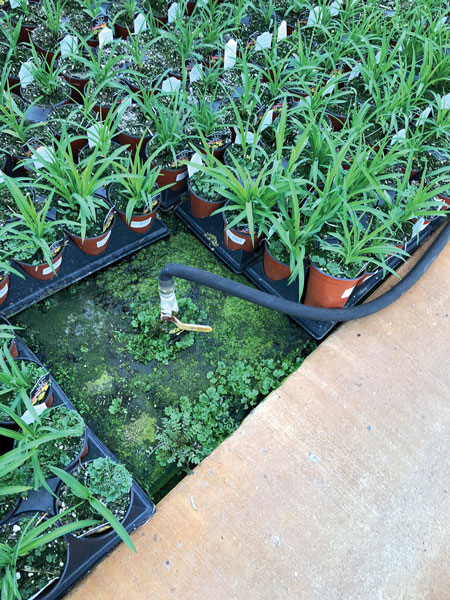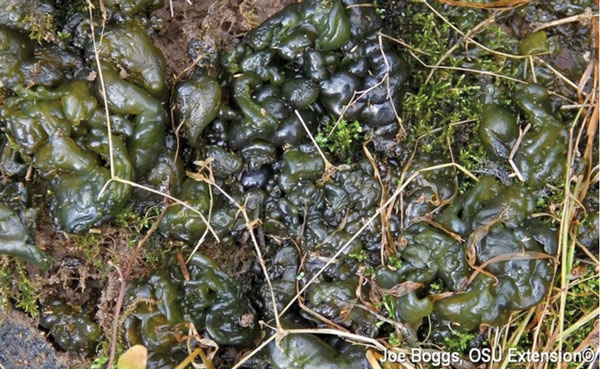8/1/2021
Weeds and Liverwort and Nostoc, Oh My!
Paul Pilon
If you grow perennials or woody ornamentals inside greenhouses or outside in production sites, I’m almost certain that you’ve observed weeds, and have likely spent tons of time and money dealing with them in the past. Weeds and weed control are, unfortunately, part of the game when you elect to grow plants, particularly when producing them outside. As cumbersome as they may be, weeds can be managed and don’t have to take over the facilities year after year.
Where do weeds come from?
There are many potential sources of weeds. They commonly blow into production sites from surrounding non-crop areas, but there are numerous other ways weeds are introduced to our crops. Weeds coming in on starting materials is a very common occurrence and source of future weed problems. I’ve seen weeds start when reusing plastic containers that weren’t properly cleaned and disinfected. The growing mix and even the irrigation water can be a source of future weeds.
Here’s the cold, hard truth: in many instances, your facility is the main source of weeds—past, present and future.
You have weeds—so now what?
Non-crop areas. There are several options available for managing weeds in non-crop areas, such as along the edges of production beds and driveways. Post-emergence herbicides can be applied to kill existing weeds. If weeds aren’t present, various preemergence herbicides can be applied to prevent them from germinating in these areas.
In situations where some weeds are present, I prefer to apply a tank mix containing both a post- and preemergence herbicide. My thinking is if I’m spraying to control existing weeds, it makes perfect sense to also prevent future weeds from germinating.
Crops. I’m surprised how many growers rely solely on hand weeding as their sole weed management strategy. Hand weeding can be effective if performed routinely enough, but does have a significant cost. In my last column (GrowerTalks June 2021), I shared Dr. Joe Neal, Weed Scientist at North Carolina State University, has determined it costs the average nursery $4,200 per acre per year to hand-weed their crops—imagine having 100 acres in production!
Controlling weeds in crops using herbicides is a little more challenging than in non-crop areas. Using postemergence herbicides on crops usually isn’t a good idea, as the herbicide that kills the weeds will likely also injure or kill the crops you apply them to.
There are several preemergence herbicides that can be applied to crops to prevent weed seeds from germinating. Plant safety is still a concern with preemergence herbicides—no herbicide is safe on all plants—but these tools can often be effectively used to manage weeds in crops and to reduce weed management costs by 70% or more.
Keep in mind that most injury following preemergence herbicide applications occur as the result of physical contact with the herbicide applied to the foliage of the crop. In some instances, injury can occur from volatilization that often occurs before the herbicide has been properly incorporated or watered in to establish the chemical barrier near the surface of the container. (See the sidebar for application guidelines that can be followed to increase crop safety and the efficacy of these applications.)

Other weeds
Liverwort
Liverwort (Marchantia polymorpha) commonly occurs on the surface of liners, containerized plants and on the ground in or near crop areas. They’re not true plants; they’re more of a primitive life form like mosses. Liverwort don’t have true leaves, rather leaf-like structures called thalli and they don’t have true root systems—instead liverwort has rhizoids. They reproduce sexually through spores and asexually by gemmae.
If you have a history of liverwort at your facility, take this to heart—you’re the source of the liverwort you’ve been experiencing. Once you can accept this, you can begin to take aggressive actions to prevent and control liverwort.
Pictured: Liverwort commonly spreads from the floors up on to the crops, as seen in this crop of daylilies.
From my own personal experience, the number one strategy you can implement in the battle to combat liverwort is to control the liverwort in the production areas. This entails cleaning, disinfecting and applying herbicides (where applicable—see product labels) to the groundmat and surrounding areas where liverwort is present. I’ve found preemergence herbicides containing flumioxazin provide excellent pre- and postemergence control of liverwort. Products containing dimethenamid provide preemergence only control. I encourage you to be aggressive in this endeavor and find ways to treat these areas multiple times over the next year or two, even if you have to move plants to do so.
The quest to conquer liverwort also entails taking care of liverwort that’s growing on the crops themselves. Crop safety and applying herbicides according to the label are the key considerations here. I’ve found applications of flumioxazin to dormant crops to be quite safe and effective; as the temperatures warm up, the existing liverwort dies and the herbicide prevents new liverwort from appearing for several months. Several growers have found dormant applications of sodium bicarbonate (NaHCO3) or baking soda to be quite effective, particularly on dormant woody ornamentals.
Don’t forget about the cultural steps you can follow. Finding ways to keep the surface of the growing mix dry can go a long way toward reducing the establishment of liverwort. This is best done by applying a coarse mulch—such as rice hulls, hazelnut shells or coarse bark—on top of the containers.
It’ll take serious commitment and dedication along with a combination of the methods above to significantly reduce, and hopefully, eliminate liverwort from your production facilities, but believe me, it can be done.
 Nostoc
Nostoc
Nostoc is an alien-like, dark blue-green, jelly-like organism that frequently develops in wet areas of outside production facilities. They look like green to brown slimy, globby mats. Although commonly called nostoc algae, it’s not an algae or a plant, it’s a cyanobacterium. Nostoc forms single-celled, threadlike structures called filaments that form colonies that are held together by a jelly-like covering. Nostoc is very slippery, especially when wet.
Pictured: Nostoc can be identified by its primitive gelatinous brown to green masses. It can be very slippery when wet and is definitely a safety hazard.
There have been very few tools that have proven themselves highly effective at controlling nostoc. Limited results have been obtained with products containing potassium salts of fatty acids.
An answer is on the way: OHP, Inc. has found that its bactericide Kalmor (copper hydroxide) is highly effective and offers season-long control of nostoc. Kalmor is currently not labeled for this application, but OHP has submitted this application to the EPA and expects it’ll soon be added to the label. From what I’ve seen, I expect this formulation of copper hydroxide will become a valuable tool for nostoc prevention and control.
Application Guidelines for Preemergence Herbicides
Granular formulations
• Granular herbicides should only be applied when the foliage is dry. Never apply them when the foliage is wet from dew, condensation, irrigation or rainfall, otherwise crop injury is likely to result.
• Always irrigate immediately following the application using ¼ to ½ in. of water to remove the granules from the leaves and to establish the chemical barrier.
Liquid/sprayable formulations
• To increase plant safety, it’s very important to wet the leaves prior to spraying preemergence herbicides over the top of crops. Spray applications can be made while it’s raining.
• Rinse off the foliage immediately following the application using ¼ to ½ in. of water. This reduces the risk of injury to the crops and establishes the chemical barrier.
It’s essential to apply both granular and sprayable formulations properly. Follow the instructions on the product labels and take steps to apply the intended amount of herbicide over the intended area. Under-applying herbicides often leads to unsatisfactory weed control; overapplying them increases the chances of crop injury. GT